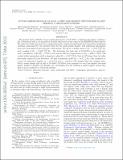SPITZER OBSERVATIONS OF GJ 3470 b: A VERY LOW-DENSITY NEPTUNE-SIZE PLANET ORBITING A METAL-RICH M DWARF
Author(s)
Demory, Brice-Olivier; Torres, Guillermo; Neves, Vasco; Rogers, Leslie; Gillon, M.; Horch, Elliott P.; Bonfils, Xavier; Delfosse, Xavier; Forveille, Thierry; Lovis, Christophe; Mayor, Michel; Santos, Nuno; Seager, Sara; Smalley, Barry; Udry, Stephane; Sullivan, Peter W.; ... Show more Show less
DownloadSeager_Spitzer observations.pdf (1022.Kb)
OPEN_ACCESS_POLICY
Open Access Policy
Creative Commons Attribution-Noncommercial-Share Alike
Terms of use
Metadata
Show full item recordAbstract
We present Spitzer/IRAC 4.5 μm transit photometry of GJ 3470 b, a Neptune-size planet orbiting an M1.5 dwarf star with a 3.3 day period recently discovered in the course of the HARPS M-dwarf survey. We refine the stellar parameters by employing purely empirical mass-luminosity and surface brightness relations constrained by our updated value for the mean stellar density, and additional information from new near-infrared spectroscopic observations. We derive a stellar mass of M[subscript *] = 0.539[+0.047 over -0.043] M[subscript ʘ] and a radius of R[subscript *] = 0.568[+0.037 over -0.031] R[subscript ʘ]. We determine the host star of GJ 3470 b to be metal-rich, with a metallicity of [Fe/H] = +0.20 ± 0.10 and an effective temperature of T [subscript eff] = 3600 ± 100 K. The revised stellar parameters yield a planetary radius Rsubscript p] = 4.83[-0.21 over +0.22] R[subscript ⊕] that is 13% larger than the value previously reported in the literature. We find a planetary mass M[subscript p] = 13.9[+1.5 over -1.4] M[subscript ⊕] that translates to a very low planetary density, P[subscript p] = 0.72[+0.13 over -0.12] g cm[superscript –3], which is 33% smaller than the original value. With a mean density half of that of GJ 436 b, GJ 3470 b is an example of a very low-density low-mass planet, similar to Kepler-11 d, Kepler-11 e, and Kepler-18 c, but orbiting a much brighter nearby star that is more conducive to follow-up studies.
Description
Author's final manuscript: March 7, 2013
Date issued
2013-04Department
Massachusetts Institute of Technology. Department of Earth, Atmospheric, and Planetary Sciences; Massachusetts Institute of Technology. Department of Physics; MIT Kavli Institute for Astrophysics and Space ResearchJournal
The Astrophysical Journal
Publisher
IOP Publishing
Citation
Demory, Brice-Olivier, Guillermo Torres, Vasco Neves, Leslie Rogers, Michael Gillon, Elliott Horch, Peter Sullivan, et al. “ SPITZER OBSERVATIONS OF GJ 3470 B: A VERY LOW-DENSITY NEPTUNE-SIZE PLANET ORBITING A METAL-RICH M DWARF .” The Astrophysical Journal 768, no. 2 (May 10, 2013): 154.
Version: Author's final manuscript
ISSN
0004-637X
1538-4357